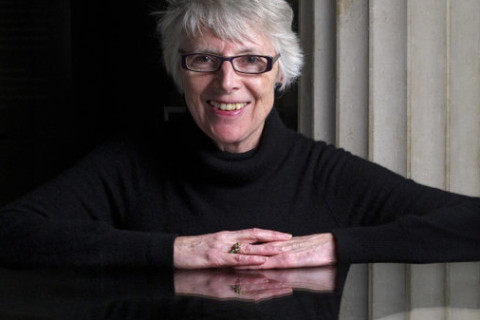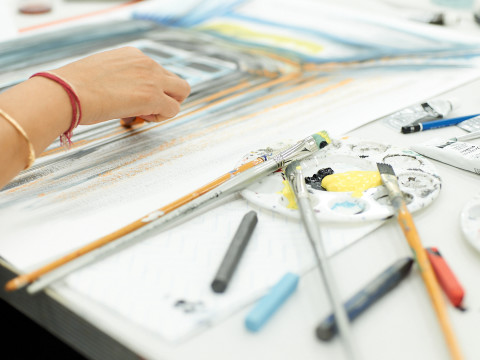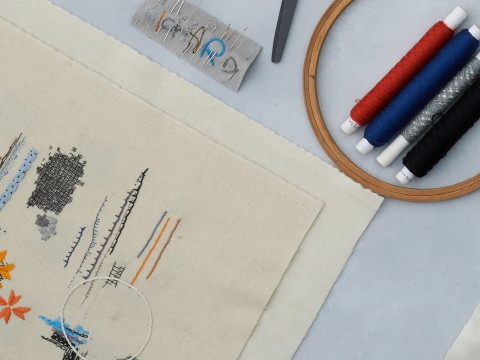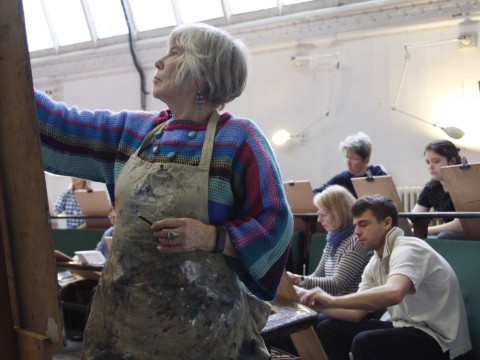
Origins of painting: from cave to Cleopatra
Weekend-long art history course
24 November 2018 10am - 5pm25 November 2018 10am - 5pm
General Assembly Room, Burlington House, Piccadilly
£420. Includes all materials, light refreshments at the beginning of each day and wine reception at the end of day one.
Terms and conditions
This weekend course, led by antiquities expert Judith Nugée, explores the rich and sophisticated origins of painting in the ancient world.
It might be tempting to assume that representational and naturalistic painting developed in western art only in the Renaissance period and later. This course will challenge this common assumption and explore the highly sophisticated painting that was already flourishing over 1,500 years earlier, which sparked a tradition spanning millennia.
Following the success of the course Essential forms: Antiquities and universal motifs, held for the first time at the RA earlier this year, antiquities expert Judith Nugée returns with a stellar cast of experts to explore the fascinating topic of the origins of painting in ancient civilisations.
As early as 30,000 years ago, people were producing elaborate representational cave paintings. The great ancient civilisations of Greece, Rome, Egypt and Mesopotamia saw the development of painting on wood, papyrus, ivory and linen – as well as three-dimensional supports including architecture, sculpture, ceramics and glass. Many of the great masterpieces of classical painting do not survive and are known to us only through mosaic copies or in literary references – but, nevertheless, the accomplishment in painting in these great civilisations is breath-taking. In these artefacts, we see techniques such as trompe-l’oeil, pseudo-perspective and sfumato which are astonishing in their complexity.
During this two-day course, experts will share their knowledge on such questions as: what motivates humans to create art? Can one truly speak of artists – as opposed to artisans – in the ancient world? They will take participants on a journey from man’s earliest cave paintings to the paintings and drawings of the great civilisations of antiquity which provide the foundation for the art of today.
Drawing and painting from Ancient Egypt over a period of three thousand years will be closely studied, from magnificent tomb frescoes and painting on papyrus to fascinating ostraca – limestone flakes bearing unofficial private ‘cartoons’ or parodies never intended to be seen publicly. In Ancient Mesopotamia, from the minute to the monumental, we will look at rare drawings found on cuneiform tablets as well as highly colourful Assyrian reliefs.
From the Greek world, the earliest frescoes from the Minoan civilisation of Crete and the Mycenaean civilisation of mainland Greece at the end of the second millennium BC to frescoes in Macedonian tombs in the fourth century BC will be discussed alongside painting on architecture, sculpture, mosaic and Greek vases.
Finally, Roman painting, largely preserved in the form of wall paintings, will be carefully explored as well as the remarkable Fayum portraits, the highly characteristic and realistic mummy portraits produced in Egypt during the Roman period, the oldest known portraits in the world and masterpieces of painting in antiquity.
£420. Includes all materials, light refreshments at the beginning of each day and wine reception at the end of day one.
Terms and conditions
About the course
This course provides an introductory overview to ancient painting, spanning over 5,000 years and several continents including the civilisations of ancient Greece Rome, Mesopotamia, the Near East, Egypt and the cultures of the Mediterranean basin.
The course provides an opportunity to explore art history through its material culture and learn from leading scholars, as well as art-world practitioners who have direct experience of handling, exhibiting and curating ancient objects and practical knowledge of the market for collecting.
This course is suitable for all levels and those with general, as well as specific, interests in antiquities.
This course is for you if:
• You are interested in an historical introduction and overview of painting in the ancient world across regions and cultures
• You have a broad interest in painting, art history and/or the collecting and trade of antiquities
• You are interested in the curation, display and exhibition of ancient paintings
• You enjoy working in a peer-group environment, using objects to learn
Minimum age 18

About the Course Leader
Judith Nugée
Founder, Hornsby + Nugée
Judith Nugée is a specialist in antiquities who has been working in the field for over 30 years. Captivated by the ancient world, Judith read Classics at Oxford University, before joining Christie’s, where she became Head of the Antiquities Department. In 2009 she founded Hornsby + Nugée, an antiquities consultancy. Her work includes valuations, researching ancient objects, and advising on acquisition or sale. She has lectured widely on antiquities and has been involved in the research, cataloguing and valuation of major finds, including the acclaimed Staffordshire Hoard. Judith will be joined by a number of expert guest speakers from antiquities and the art world.
About the speakers:

Emerita Fellow, Wolfson College
University of Oxford
Honorary Curator
Ashmolean Museum
Susan Walker spent her working life as a museum curator, in the British Museum from 1977 to 2004 and as Sackler Keeper of Antiquities in the Ashmolean Museum, Oxford from 2004 until her retirement in 2014. In 1997 she co-curated with Morris Bierbrier Ancient Faces: Mummy Portraits from Roman Egypt, a British Museum exhibition that enjoyed success in London, Rome and New York, where she was sole guest curator for the Metropolitan Museum of Art’s presentation and associated publication. The exhibition also inspired displays in Greece, Vienna, Paris and Frankfurt. Susan Walker is now an Emerita Fellow of Wolfson College, University of Oxford and an honorary curator at the Ashmolean, where she is now working on mummy portraits with Jevon Thistlewood of the Department of Conservation. She recently published Saints and Salvation: the Wilshere Collection of late Roman gold-glass, sarcophagi and inscriptions from Rome and Southern Italy (Ashmolean Museum, 2017).

Assistant Professor in Ancient Greek and Roman Art
University of Nottingham
Dr Tiziana D’Angelo is an Assistant Professor in Ancient Greek and Roman Art in the Department of Classics and Archaeology at the University of Nottingham. Prior to that, she was a fixed-term Lecturer in Classical Art and Archaeology at the University of Cambridge and a Fellow of St Edmund’s College. She received her BA in Classics from Collegio Ghislieri, Università degli Studi di Pavia, her MPhil in Classical Archaeology from the University of Oxford and her PhD in Classical Archaeology from Harvard University. She has also held research fellowships from the Metropolitan Museum of Art in New York (2013-2014), the Deutsches Archäologisches Institut in Berlin (2013), the Getty Research Institute in Los Angeles (2012-2013), and the Phi Beta Kappa Society in Washington, DC (2011-2012). Dr D’Angelo specialises in ancient Mediterranean art and archaeology, with a focus on southern Italy from the Archaic to the Roman period. She is especially interested in ancient wall painting and its modern reception, funerary art and material culture, and the history of collecting. She is currently finishing her first monograph, Colour, Death and Identity: Ancient Wall Painting in Southern Italy, and has recently co-edited Collecting and Collectors from Antiquity to Modernity (Boston, Archaeological Institute of America, 2018).

Emeritus Professor, Faculty of Humanities
University of Southampton
Clive Gamble is an Emeritus Professor in the University of Southampton’s Faculty of Humanities where he leads interdisciplinary research projects and publishes widely on the archaeology of human origins. He is a Visiting Professor in the Department of Geography at Royal Holloway, University of London, and has held positions at Universities in the United States and Australia. Clive undertakes pioneering research into the social life of our earliest ancestors and in particular investigates the timing of global colonisation. His research has led him into many parts of the world, some of them remote, to answer the questions; when and why did we become the only species in human evolution to cover the entire globe? Clive is a Fellow of the British Academy, the Society of Antiquaries and the Royal Anthropological Institute. When not thinking about the past and deep-history he is engrossed by cricket, cats and the garden.

Head of Department, Ancient Sculpture and Works of Art
Sotheby’s
Dr. Florent Heintz joined Sotheby’s Ancient Sculpture & Works of Art department in 2001. Prior to coming to Sotheby's, Dr Heintz worked as Keeper of the collection of ancient coins at the Fogg Art Museum and as Curatorial Assistant at the Worcester Art Museum, Worcester, Massachusetts. His publications include a monograph, Simon le Magicien (1997), several articles in academic journals such as Zeitschrift für Papyrologie und Epigraphik, the Journal of Roman Archaeology and the American Journal of Numismatics, and contributions to exhibition catalogues such as his object entries and essay on Roman Magic in Antioch: The Lost Ancient City (Princeton University Press, 2000). Dr Heintz obtained a Master's degree in Philosophy from the University of Lyon, France, a Doctorate of Theology degree from the University of Strasbourg, France, and a PhD in Classical Archaeology from Harvard University.

Managing Director
Charles Ede Ltd
Since early 2014 Martin Clist, has been the Managing Director of Charles Ede (established 1971). He studied Fine Art at university, completing his postgraduate masters at the Slade School, London. He has worked in the London art world for more than three decades, initially with Nick Serota at the Whitechapel Gallery, before moving to the commercial world, firstly at Waddington Galleries and later Karsten Schubert. For 17 years he was at Rupert Wace Ancient Art, followed by four years with Rossi & Rossi, leading dealers in Tibetan art.

Postdoctoral Research Fellow
University of Heidelberg
Having completed her diploma studies in Classical Archaeology, Ancient History and Pre- and Protohistory at the University of Vienna, Austria, Ute Günkel-Maschek became a fellow of the graduate academy “Spaces, Images, Ways of Life in Ancient Civilizations” at the Centre for Ancient Studies, University of Heidelberg, where she wrote a doctoral thesis on the interplay of wall-painting, architectural space and human action in the palace societies of Minoan Crete. Ute has published papers on Minoan art, the most recent being a co-authored study on The power of images: re-examining the wall paintings from the Throne Room at Knossos (with Yannis Galanakis and Efi Tsitsa), as well as on childhood and adolescence in the Bronze Age Aegean, including a chapter on Children and Religion in the Aegean Bronze Age for a Routledge handbook on Children in Antiquity (in press). She is currently a postdoctoral research fellow at the University of Heidelberg and principle investigator in a research project which aims to identify and visualise patterns in representations of gestures in Minoan art.

Our courses and classes programme
Our programme of short courses and classes offers the opportunity to explore a range of subjects, led by expert tutors and practising artists.
Related events
 Short courseFree
Short courseFreeThe Primary Art School
9 January - 12 June 2025
 Short course
Short courseModernism around the world
4 February - 11 March 2025
 Short course
Short courseThe Art of Carnival
1 March 2025
 Short course
Short courseBotanical art
11 March - 8 April 2025
 Short course
Short courseExploring ink: method and imagination
29 March - 30 March 2025
 Short course
Short courseDepicting the figure: Renaissance to Modernism
29 April - 27 May 2025
 Short course
Short courseRevolutionaries and Romantics: art and literature in France
17 May - 18 May 2025
 Short course
Short courseOil painting: techniques and discovery
17 May - 18 May 2025
 Short course
Short courseSketch with stitch
21 June - 22 June 2025
 Short course
Short courseConnoisseurship summer school: who painted what, when and how to tell
1 July - 5 July 2025
 Short course
Short courseLife drawing summer school
8 July - 12 July 2025
 Short course
Short courseDrawing with anatomy
15 July - 19 July 2025
 Short course
Short courseExpressive life drawing: observation and imagination
15 July - 19 July 2025
 Short course
Short courseLandscapes: van Gogh and his influence
2 September - 6 September 2025